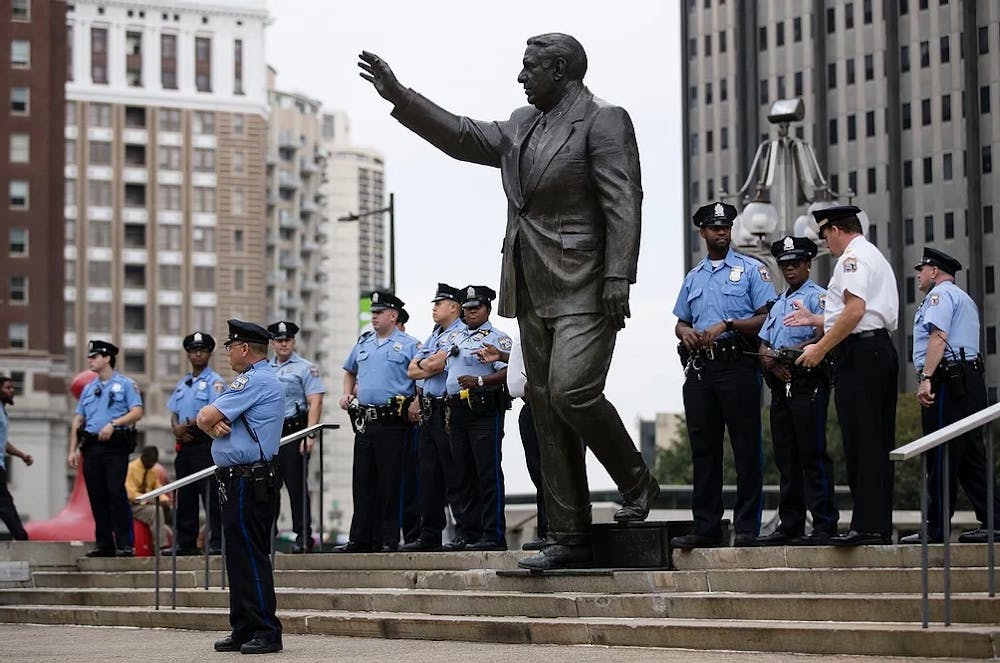The Frank Rizzo statue, which many Philadelphians urged to be relocated after the Charlottesville riots in 2017, will remain in its original spot until at least 2021. Frank Rizzo was a colorful figure in Philadelphia politics and a man who our city will never forget - both for reasons positive and negative - depending on who you ask. Born to an Italian-American South Philadelphia family in 1920, Rizzo’s professional career remains controversial in Philadelphia politics. He served as the Commissioner of the Philadelphia Police Department before being elected mayor in 1971. Seven months after Frank Rizzo’s death in 1991, a group of Rizzo’s supporters planned the construction of a massive ten-foot, 2,000-pound statue of the former mayor that would soon find its home on the steps of the city’s Municipal Services Building. Before I learned about Frank Rizzo’s checkered role in Philadelphia politics, his statue represented nothing more to me than a city commemorating a seemingly stern, waving man. It wasn’t until a few weeks ago when I watched a documentary titled Amateur Night at City Hall: The Story of Frank L. Rizzo, that I realized the complex man Frank Rizzo truly was.
I remember noting the dichotomy between the interviewees in the film. Like most politicians and law-enforcement officials, Frank Rizzo had friends and enemies. However, I noticed that many of the Philadelphians who favored Rizzo were older white people. They loved him for his South Philadelphia roots, his authoritative law-and-order nature, and his promise to be “firm but fair.” Unfortunately, Frank Rizzo was not as fair as his campaign slogan made him out to be. During his time serving as Police Commissioner, Rizzo was responsible for initiating and participating in infamous acts of police brutality. Most notably was the attack of the 1967 Black Student Walkouts. On November 17, 1967, a crowd of students from across the city gathered in front of the former Board of Education building to protest issues in Philadelphia Schools. Public school students and educators, along with private school students who joined in solidarity, demanded better conditions in school buildings, the hiring of more administrators of color, and implementing mandatory African American history studies in all public schools. Although these students protested peacefully, Frank Rizzo ordered hundreds of police officers to intervene upon the protest with nightsticks and a hunger for violence. According to a bystander, Rizzo was heard to have ordered his officers to “get [the protestors’] black asses” before sending them to attack. This violation of the students’ rights to exercise free speech and to assemble peacefully was an act that shaped Frank Rizzo’s reputation years before his mayorship.
During Frank Rizzo’s time in office, Philadelphia’s crime rates were lower than in years prior. Though this information is statistically positive, Philadelphia’s police-turned-mayor had otherwise no influence on the city’s progress. Rizzo preferred to be feared than loved, and his tough cop persona led to intense resistance to crime in the city. His supporters appreciated the lower crime rates, the high-speed rail line to the airport, and the booming city construction that Rizzo was partially responsible for. However, Philadelphians of minority and often marginalized groups feared Frank Rizzo. Black Philadelphians angrily reflected on the 1967 Black Student Walkout attacks and the 1970 Headquarter Raids of the Philadelphia Black Panthers, during which Rizzo led hundreds of officers to strip Black Panthers of their clothing and to search them in the streets. Philadelphians who identified as members of the LGBTQ+ community did not forget Frank Rizzo’s use of homophobic slurs in press interviews and his Saturday-night round-ups of gay men during his police days that were based solely on suspicion.
As a native Philadelphian and student of a Philadelphia public school, I believe it is inappropriate for my city to honor a leader who led with prejudice and intolerance. Philadelphia school students should not have to walk past a statue of a man who infringed upon the rights of students who walked out of school over fifty years ago. Students and educators in 2020 identify with the same worries of those who protested that day. Fortunately, we can protest the unfair wages of our teachers and the gun violence that persists in schools without being detained or injured by Philadelphia Police officers. Frank Rizzo was a two-faced man who used his South Rosewood Street upbringing and his law-enforcement background to charm working-class Philadelphians, while simultaneously oppressing Philadelphia’s black community through discrimination, violence, and derogatory language.
Frank Rizzo should no longer represent Philadelphia’s rich political history, and his statue certainly should not have a home in the heart of our city. The Frank Rizzo statue is merely a reminder of our city’s troubled past, and a symbol of how much farther we have to go to eradicate racism and police brutality in this nation.




